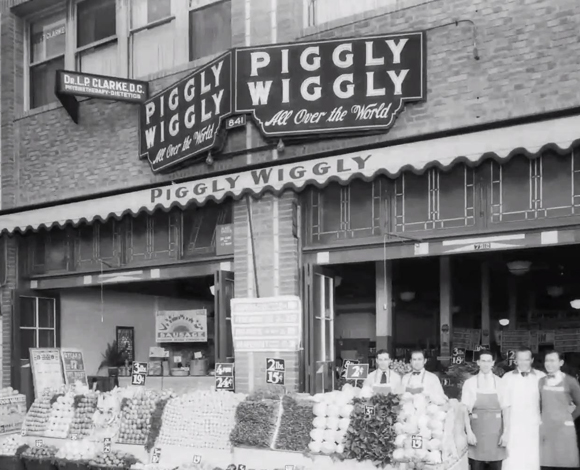超市的起源
The Innovation of Grocery Stores
- 出題日期
- 2018/3/18、2017/2/11、2016/4/2
- 命中課本
- 菁英雅思機經「歷史,社會,文化與經濟」
- 延伸閱讀
- 劍雅 4-3-1 Micro-Enterprise Credit for Street Youth
- 中文說明
-
 在
20 世紀初,美國雜貨店的服務模式和現在完全不同,顧客要先排隊向店員表達想買的確切物品 為何,而店員會去拿物品並包裝起來。如果顧客想省下排隊的時間,就必須先在家寫好紙條,上面說 明要買哪些東西,然後請快遞把紙條送到雜貨店,之後顧客再到商店付款取貨。這些雜貨店通常只賣
一種品牌的商品。這就是最早期的連鎖店,服務非常耗時。 1885 年,14 歲的克雷倫斯‧桑德斯(Clarence Saunders)輟學,並在當地雜貨店打工,他在這裡 找到了自己的專長,也改變了他的人生,他留給全世界的禮物「小豬商店」(Piggly
Wiggly Stores), 至今仍有 600 家店在經營,遍布於美國的 17 州,而它們就是超級市場的前身,與現代生活息息相 關...
在
20 世紀初,美國雜貨店的服務模式和現在完全不同,顧客要先排隊向店員表達想買的確切物品 為何,而店員會去拿物品並包裝起來。如果顧客想省下排隊的時間,就必須先在家寫好紙條,上面說 明要買哪些東西,然後請快遞把紙條送到雜貨店,之後顧客再到商店付款取貨。這些雜貨店通常只賣
一種品牌的商品。這就是最早期的連鎖店,服務非常耗時。 1885 年,14 歲的克雷倫斯‧桑德斯(Clarence Saunders)輟學,並在當地雜貨店打工,他在這裡 找到了自己的專長,也改變了他的人生,他留給全世界的禮物「小豬商店」(Piggly
Wiggly Stores), 至今仍有 600 家店在經營,遍布於美國的 17 州,而它們就是超級市場的前身,與現代生活息息相 關...
- 高分單字
-
full-service adj. 全方位服務的
The bank is full-service, providing all kinds of financial services for individuals and businesses.
time-consuming adj. 很花時間的
這家銀行提供全方位服務,提供個人與企業各種金融服務。Strategic planning is an extremely time-consuming process.
clerk n. 售貨員,店員
策略規劃是一個非常花費時間的過程。The clerk will wrap your purchases for you.
shopkeeper n. 店主
店員會幫你包好你買的東西。A shopkeeper is someone who owns or is in charge of a small shop.
wholesale adj. 批發的;成批售出的
店主是擁有或負責一家小型商店的人。Our business is wholesale only.
process n. 過程
我們只做批發生意。The ageing process doesn't start at the same time for everyone.
expedite v. 加速
每個人老化過程的起始點都不一樣。To expedite means to make something happen more quickly.
flamboyant adj. 炫耀的;賣弄的
「加速」就是讓某件事物更快發生。The politician's flamboyant lifestyle was well known.
revolutionize v. 徹底改革,在......方面實現突破性大變革
這位政治家的生活方式是出了名的誇張造作。This new technology is going to revolutionize everything we do.
checkout n. (超級市場等的)收銀台
這項新科技將會徹底改變我們的生活。A checkout is a point at which goods are paid for in a supermarket.
收銀台就是在超市裡付款購買物品的地點。 - 看出題原文
-
The Innovation of Grocery Stores
At the beginning of the 20th century, grocery stores in the United States were full-service. A customer would ask a clerk behind the counter for specific items and the clerk would package the items, which were limited to dry goods. If they want to save some time, they have to ask a delivery boy or by themselves to send the note of what they want to buy to the grocery store first and then go to pay for the goods later. These grocery stores usually carried only one brand of each good. There were early chain stores, such as the A&P Stores, but these were all entirely full-service and very time-consuming.
In 1885, a Virginia boy named Clarence Saunders began working part-time as a clerk in a grocery store when he was 14 years old, and quit school when the shopkeeper offered him full time work with room and board. Later he worked in an Alabama coke plant and in a Tennessee sawmill before he returned to the grocery business. By 1900, when he was nineteen years old, he was earning $30 a month as a salesman for a wholesale grocer. During his years working in the grocery stores, he found that it was very inconvenient and inefficient for people to buy things because more than a century ago, long before there were computers, shopping was done quite differently than it is today. Entering a store, the customer would approach the counter (or wait for a clerk to become available) and place an order, either verbally or, as was often the case for boys running errands, in the form of a note or list. While the customer was waiting the clerk would move behind the counter and throughout the store, select the items on the list—some form shelves so high that long-handled grasping device had to be used—and bring them back to the counter to be tallied and bagged or boxed. The process might be expedited by the customer calling or sending in the order beforehand, or by the order being handled by a delivery boy on a bike, but otherwise it did not vary greatly. Saunders, a flamboyant and innovative man, noticed that this method resulted in wasted time and expense, so he came up with an unheard-of solution that would revolutionize the entire grocery industry: he developed a way for shoppers to serve themselves.
So in 1902 he moved to Memphis where he developed his concept to form a grocery wholesale cooperative and a full-service grocery store. For his new ‘cafeteria grocery’, Saunders divided his grocery into three distinct areas:
1) A front ‘lobby’ forming an entrance and exit and checkouts at the front.
2) A sales department, which was specially designed to allow customers to roam the aisles and select their own groceries. Removing unnecessary clerks, creating elaborate aisle displays, and rearranging the store to force customers to view all of the merchandise and over the shelving and cabinets units of sales department were ‘galleries’, where supervisors were allowed to keep an eye on the customers while not disturbing them.
完整文章內容,請參閱菁英機經教材課本。
只要相信改變的力量,勇敢去改變,未來會有無限可能
相信自己!相信菁英!陪你勇敢踏出挑戰自己的第一步,創造屬於你的可能性!
線上預約諮詢
留下您的學習想法!
我們將於24小時內與您聯繫,共同規劃學習藍圖。
撥打電話聯繫
別讓前進的動力消失!立即與專員一對一討論學習計畫。
線上即時諮詢
不想等待嗎?!可與菁英專業顧問即時線上詢問;
線上諮詢服務時間:上午10:00至晚上20:00。


